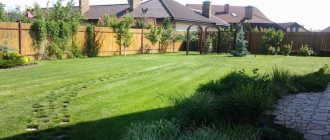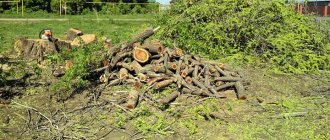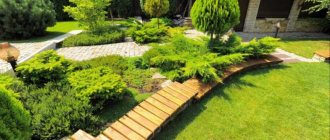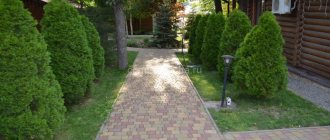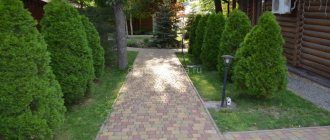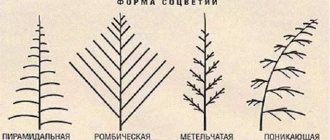A perfectly flat plot with a green lawn is the dream of any owner, but newly acquired land plots, as a rule, have a complex landscape. It is advisable to level the relief at the first stage of arranging the dacha area in order to avoid difficulties when creating landscape design. How to level a plot of land at your dacha with your own hands under a lawn is described in the article.
Principles of preparing a site for a lawn
Everyone knows what a lawn is. In fact, this is part of the territory of a suburban area on which grass for special purposes is sown. That’s what it’s called – lawn. The grass grows in short shoots that need to be mowed every 2 weeks. It is this even appearance of the grass area that gives the suburban area a presentable appearance.
But achieving evenness is the difficulty of creating a lawn. The area on which the grass is sown should be at one level. There are certain assumptions and errors, but they are insignificant and do not exceed 2 cm per meter of the length of the leveled surface.
The area for the lawn should be fairly level Source adscore.ru
At the same time, it is necessary to ensure good growth of the planting. That is, the grass should not only grow well, the stems should be juicy, of good color, tightly packed next to each other. And to achieve this, it is necessary to carry out a number of activities:
- ensure soil drainage so that water does not linger on the area under the lawn;
- distribute fertile soil , which will ensure good plant growth;
- compact the soil and soil , because most often the lawn is an area on which it is recommended to walk, that is, load;
- create an irrigation system that will be responsible for watering the grass cover.
It is necessary to note that the process of lawn formation itself begins with cleaning the area. That is, all plants are removed except trees and shrubs, which must be shaped (trimmed) to fit the landscape design. And, of course, they level the ground for the lawn.
Site preparation begins with cleaning Source fakivagas-budapest.hu
Leveling the area
The lawn can be laid out not only on horizontal areas. Inclined planes are also suitable, the main thing is that the surface prepared for sowing lawn grass is free of holes, bumps, recesses and other soil imperfections. Therefore, it is necessary to level the plane of the area.
If the lawn area is small, then all activities related to leveling can be carried out manually using rakes and shovels. If you plan to plant lawn grass over a large area, then you cannot do without equipment.
How to level the area for planting:
- First of all, marking is carried out pegs and twine are most often used ;
- designated area is being cleaned ;
- then the fertile layer is backfilled and compacted , an important point is that the thickness of the compacted soil is 14-16 cm;
- carry out soil leveling to achieve maximum evenness of the site.
Planning an area for a lawn Source a-landshaft.ru
Everything seems to be simple. But this is just a list of work being carried out, each of which has its own nuances. For example, after clearing the area of debris and vegetation, you need to remove the fertile layer of soil and place it near the future lawn. Please note that the soil can be stored in this condition for no more than one month. After a long period of aging, harmful bacteria and insects appear in it.
Then the soil is leveled. Pay special attention to holes that may need to be filled with additionally imported soil. Pay attention to the soil itself. If it is very dense, then it is worth digging up the area using shovels or other mechanical devices and devices. After digging, leveling must be carried out.
Now it is necessary to add the fertile layer of soil that was previously removed. To apply it evenly over the area, it is recommended to drive wooden pegs under the lawn throughout the entire area so that they stick out above the ground at the same height. This can be achieved by using a laser construction level as the simplest modern option.
Removing the fertile layer of soil Source torfspb.ru
See also: Catalog of companies that specialize in landscaping work on sites.
At the next stage, soil is added to the entire site. It must be leveled along the driven pegs using a rake. In this state, the earth is left to naturally shrink. This usually takes a couple of weeks.
After the soil has settled, it is necessary to check how compacted it is - whether the driven pegs protrude above the ground. If this happens, then the soil is replenished, leveling according to the marks. Do not forget that the lawn must maintain a slight slope - 1-2°, for water to drain (rain or melt). After which the pegs are removed and the soil is compacted with a metal roller.
This process is best carried out in dry, windless weather. In this case, the soil must be rolled in two perpendicular directions in order to thus avoid the appearance of air pockets in the soil. And the last stage is the collection of stones, roots and other debris that ended up in the soil. Be sure to check the level of the area intended for lawn.
Compacting the area under the lawn with a roller Source peratfor.ru
How to achieve a flat plane
Lumps and hummocks on the surface of the ground create inconvenience for walking and cutting grass with a lawn mower. Water collects in depressions after rains. And visually such an area looks unkempt and unkempt. When leveling loose soil, such defects are difficult to detect by eye. But there is a simple way to make a flat area in the country and bring it into one plane, regardless of whether it is a horizontal or inclined area.
This area needs careful leveling Source wp.com
You will need several long pegs, strong twine, a hammer and a long water level or level.
- Pegs are driven around the perimeter of the site in increments of about 1 meter.
- Using a level, marks are placed on them at the same height.
- A string is stretched between opposite pegs along and across the site. It is attached at the tag level.
- When all the strings are stretched, they form a grid of squares over the area.
- In those squares where the distance from the string to the ground is large, soil must be poured from those where it is small, achieving the same distance from the string down.
If the slope is small, the area can be brought to the horizon in a similar way. To do this, you will need a wheelbarrow, since you will have to transport large volumes of soil from a high level to a low one.
How to manually level the ground slope is described in detail in the video:
Lawn on a slope
The optimal angle of inclination of the area where you plan to lay out the lawn should not exceed 25°. Leveling a summer cottage plot for a lawn located on a slope of more than 25° is carried out as follows:
- first of all, the fertile layer is removed , which is transferred to temporary storage near the site;
- then the layer of soil located in the upper part of the slope is transferred to the lower parts , where it is leveled and evenly distributed ;
- The main task of the work manufacturer is to reduce the angle of inclination .
In this case, it is recommended to form a terrace at the bottom of the slope. To do this, a curb is constructed at the bottom of the slope. This could be an earthen embankment, although different options are offered. The main thing is that the curb must be strong and reliable. After that, a ditch is dug along the curb, the purpose of which is to drain rain and melt water, as well as excess irrigation. Therefore, the ditch is dug at a slope towards the drainage.
Now everything is the same as in the previous case. Thus, the fertile layer is removed, part of the soil from the upper part of the slope is transferred to the lower part, and the terrace is filled. And the last thing is filling the slope and terrace with soil that was previously removed from the slope.
Formation of a green lawn on a slope Source www.ldgrand.ru
Preparatory work
First, the area is completely cleared of:
- construction and household waste;
- stumps;
- branches;
- shrubs (carefully dug up and transplanted to another place);
- stones;
- paths and other concrete structures.
Stumps do not have to be uprooted.
There are means for chemical decomposition of wood. Saltpeter is also used for this purpose. Then the fertile layer is cut off and placed in heaps along the borders of the cultivated area. If this is not done, during the leveling process the upper and lower layers will be mixed, which will negatively affect the fertility of the site.
It is allowed to store cut soil for no longer than 3-4 weeks. With longer exposure in the soil, important microorganisms responsible for gas exchange die.
Revival of the lawn
There are often situations when the owners of a suburban area neglect their lawn. Grass grows on it at full height, weeds, uneven ground, etc. have appeared. Reviving a lawn is not an easy task. Essentially, you have to redo everything all over again, which takes a lot of time. Here it is important to properly level the old area of lawn under the new lawn.
In fact, the old lawn is located on an area that was already leveled at some point. But under the influence of natural stress, it gradually lost both its evenness and its fertility. A littered area requires practically one operation - digging up. This process is classified into two types of digging: single- and double-tier.
Feasibility
Leveling the site before sowing lawn grass mixture is necessary, since the presence of unevenness will lead to the following undesirable consequences:
- the lawn loses its attractiveness;
- bald spots appear: seeds are washed away by rain from highlands to lowlands;
- When watering, water stagnates in lowlands, causing the grass to become sick;
- the haircut is done unevenly: in the lowlands it is too long, in the hills it is almost “zero”. If there are significant differences in height, cutting is generally impossible - there is a risk of damaging the lawn mower;
- injury hazard. When children frolic in outdoor games, they often run onto the lawn, and if it is strewn with bumps, falls are inevitable.
They also resort to leveling the site if it is planned to:
- setting up a vegetable garden;
- pool installation;
- building a house or fence.
At the same time, one should be aware of the high labor intensity of such work.
If you do not plan to create objects, it would be wiser to resort to an easier method:
- hide unevenness by planting a flower bed;
- plant berry bushes, for example, currants: this will also make the relief less noticeable;
- beat up the irregularities by arranging a decorative pond, a rock garden, or a corner decorated in a fairytale style.
Useful tips
Experts make several recommendations that will improve the quality of the final result:
- It is not worth using heavy equipment in the form of a bulldozer to level the area . Special equipment of this type is heavy, and its tracks can ruin the fertile layer of soil. Therefore, the maximum that can be used is a small tractor.
- It is better to use a cultivator to loosen and dig up .
- It is optimal if the digging is carried out in the fall , leaving the soil in this state throughout the winter . The overturned clods will freeze through, which means the weed roots also freeze .
- to dig up the soil with a cultivator in different directions . This is done already in the spring.
- If the area intended for the formation of a lawn is heavily covered with weeds , then it is better to use herbicides . It is important to choose a chemical that is suitable for certain types of weeds.
- If old stumps on the lawn , then they can be uprooted or covered with saltpeter , after which they will turn into dust.
Construction location analysis
Area for laying the foundation When laying the foundation, you should conduct an in-depth analysis of the area:
Determine the type of soil. There are two types: natural and artificial. Natural soil for the future foundation provides high strength. Artificial - requires additional compaction. This can be achieved by tamping or using chemical components. Correctly determine the terrain. Are there any elevation changes and by how much? Determine the depth of soil freezing. For different types of soil, this factor affects the load-bearing characteristics of the foundation differently.
Much attention should be paid to heaving soils (clayey, marshy). In any case, the foundation should be laid below the freezing depth of the soil by at least 20 cm. An important factor for choosing the type of foundation is the groundwater level.
Tamping
Lawn preparation includes tamping. For future sowing of seeds, the soil must be compacted. Compact the dug up and leveled soil with a hand roller weighing approximately one hundredweight. Although you can use a simple board. No one should be allowed to roll the earth after or during rain. Walking on compacted and compacted soil is not allowed. Carefully compacted soil will allow the seeds to lie evenly in the ground, and this in turn will help them swell and sprout.
We have figured out how to compact the soil under the lawn, now let's move on to the next final stage.
How to level it yourself (with the help of small mechanization)
If the area is small or there is no way for special equipment to enter it, you can try to level the area yourself. It is advisable if several adult men take on the work, firstly, this will speed up all the rough physical work, and secondly, the result will be more accurate, because more than one pair of eyes will be watching the alignment process. It all starts with marking and placing vertical beacons on pegs - in this case, pegs are installed only on elevations and slides. When all the rising points are marked in the area we are working on, we proceed to the second stage - using a construction rod or a pre-selected board with a perfectly flat side, we combine two nearby peaks, the resulting gap between the soil and the flat side of the rule or board is thrown earth and level the top layer. After all the irregularities between the designated peaks are filled in at once, the entire surface of the area on which we worked will be an order of magnitude smoother. If you are not yet satisfied with the result, you need to repeat the markings at high points again and once again fill all the cracks that have formed on the leveled area with earth. Next, you need to compact all the poured earth; instead of an industrial vibrating plate or roller, you can use an old barrel, throwing stones, bricks, concrete mixture or the same earth into it for greater pressure on the ground. You can attach wooden handles to it to make it easier to roll.
How to level a site with a cultivator:
Weed removal
To create lawns, special grasses are grown that delight the eye with rich colors and give pleasant tactile sensations
Any weed will spoil the impression, so it is important to get rid of extraneous vegetation
Two methods are used:
mechanical. The turf is cut to a shallow depth and stacked with the roots facing up. After six months, the cut soil is used as humus: it is free of weeds and rich in nutrients;
chemical. The area is treated with herbicides, for example, Roundup or Reglon. The poison affects the plants completely, penetrating through the aboveground part into the roots, so that after a few days the area becomes clean
When using pesticides, it is important to strictly follow the instructions, otherwise they may subsequently harm beneficial plants.
To avoid damage to lawn grass by the herbicide, sowing should begin no earlier than 6 weeks after treatment. During this period, weeding is carried out regularly, destroying the remaining weeds.
Digging up soil
After cleaning the area, the soil for the lawn is dug up. If this area of land was previously cultivated, you can use a simple single-tier digging, allowing you to work to the depth of one shovel bayonet. If we are talking about soil that has not been processed for a long time, two-tier digging will be required. To do this you need to do the following:
- Dig a furrow across the entire area with one bayonet of a shovel.
- Use a pick to loosen the bottom layer of soil.
- Dig the next furrow and fill the previous one with soil removed from it.
- The last furrow is filled with the same soil that was dug at the very beginning.
